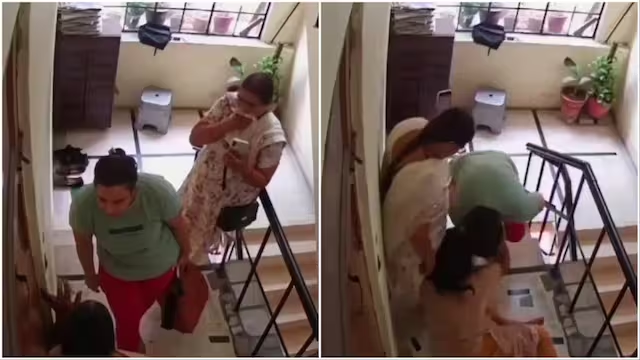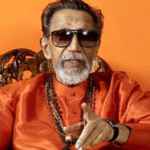Ghaziabad Shocker: Woman Caught on Camera Assaulting 65-Year-Old Mother-in-Law Outside Home — Filmed by Her Own Mother
A woman was assaulted by her daughter-in-law in Ghaziabad’s Govindpuram area, with CCTV footage of the July 1 incident going viral. An FIR in the case was registered
A woman was brutally thrashed by her daughter-in-law in Ghaziabad after an argument between the two.
A CCTV video of the incident was widely shared on social media, showing the daughter-in-law in an argument with her mother-in-law on the staircase outside their house.
Another woman, believed to be the mother of the daughter-in-law, could be seen standing beside her, filming the entire episode.
As the argument between them turned violent, the mother-in-law could be seen attempting to snatch the mobile phone of her daughter-in-law’s mother.
As she gets up to snatch the phone, she is assaulted by her daughter-in-law, who repeatedly thrashes her until someone opens the door of their house.
The video is believed to be from the Govindpuram area, and the incident happened on July 1, according to multiple media reports.
A report with India Today identified the accused as Akanksha, while her mother-in-law was named as Sudesh Devi.
The report also claimed that Sudesh Devi was forced to make multiple visits to the police station to seek justice and that the police had initially refused to lodge a complaint in the case.
A First Information Report (FIR) was later filed in the case.
It was alleged that the daughter-in-law’s family had connections within the police department, the report mentioned.
In another incident, a man was beaten up allegedly by a group of nine persons in Maharashtra’s Jalna district after he objected to them passing lewd remarks at his daughter.
A video of the assault, which took place in Yamuna Nagar last week, went viral on social media.
It showed the minor girl pleading with the mob not to hit her father.
Ghaziabad, July 7, 2025 — A deeply disturbing incident from Uttar Pradesh’s Ghaziabad district has sent shockwaves across social media and sparked widespread condemnation. A software engineer, Akanksha (name changed), allegedly brutally thrashes her 65‑year‑old mother‑in‑law outside their home, while her own mother films the entire ordeal. The violent episode, captured on a private CCTV camera, led to their FIR and arrests after public outrage forced police action.
The harrowing incident took place in a residential colony of Ghaziabad. The CCTV footage—posted online by reporter Shonee Kapoor—shows Akanksha dragging her elderly mother-in-law by her hair, slamming her against a wall, and repeatedly hitting her. Her mother can also be seen recording the assault on her phone, a silent witness to the brutality .
The victim, Sudesh Devi, is reportedly in her mid-60s. Those who watched the footage say she appears defenseless and in shock, pleading silently for mercy. Netizens responded with shock and disgust, calling the video “Ghaziabad shocker” and demanding swift justice .
Days after the assault, the Ghaziabad police delayed registering an FIR, allegedly citing local connections and lack of immediate evidence. Victim’s family reports indicate multiple prior complaints had been dismissed. However, once the video went viral, public backlash intensified and the police finally responded, filing an FIR under Indian Penal Code sections related to domestic violence and assault .
Both the daughter-in-law, Akanksha, and her mother—who filmed the act—are now officially booked. Authorities report ongoing investigations, and the accused are currently in custody.
CCTV as Guardian: As in many distressing domestic cases, CCTV footage played a critical role—capturing the violence and providing unambiguous evidence .
Public Pressure: Social media uproar prompted swift police action after initial inaction, reflecting growing intolerance for domestic elder abuse.
Societal Reflection: The fact that the assailant’s own mother recorded the crime adds a chilling layer—raising tough questions about respect and empathy within family units.
India’s legal framework includes the Maintenance and Welfare of Parents and Senior Citizens Act, 2007, which penalizes abandonment and mistreatment of elders. However, activists often criticize slow enforcement and lack of awareness.
Similar cases across the country have prompted calls for stricter measures:
- In Bijnor, 2016, a 45-year-old daughter-in-law brutally assaulted her 70-year-old mother-in-law with a brick and rope. The assault was recorded on CCTV by her husband, leading to her arrest under attempt-to-murder charges
In Haryana, 2020, police arrested a woman for attacking her 80-year-old mother-in-law in public—an act that drew condemnation from politicians, including the state’s Chief Minister Minohar Lal Khattar
These incidents highlight that elder abuse by in‑laws is not isolated and recurring enforcement failures demand deeper scrutiny of legal safeguards.
Mandatory CCTV in elder-care households—to document mistreatment.
Faster police response to protect seniors.
Targeted awareness campaigns among young couples about elder rights and empathy.
- Erosion of familial respect: Elders traditionally hold authority in Indian joint families. Such violent incidents indicate deep fractures in these values.
- Misuse of protective laws: While protections exist, activists caution that Section 498A (anti-dowry law) is often misused—prompting backlash and enabling reciprocal domestic abuse by women .
- Legal equality: Most domestic violence protections target women as victims. But these incidents underscore the need for gender-neutral enforcement to ensure elder rights are respected .
- Silence of male heirs: Observers criticize the son’s apparent passivity—despite being present, he neither intervened nor reported the violence immediately.
Spike in elder abuse cases: Multiple recent cases make it clear: elder abuse is no longer just sporadic. Society must address it as a pressing concern—with laws and stigma evolving accordingly.
Importance of technology: CCTV continues to be pivotal in exposing domestic crimes, though legal frameworks should ease admissibility and protection for whistleblowers.
Changing family roles: Women’s empowerment is vital, but it must be coupled with interpersonal respect and equality—not tit-for-tat vengeance under the guise of emancipation.
Policy overhaul needed:
- Expand legal definitions and protections under senior citizens’ laws.
- Ensure police training includes responding to elder abuse.
- Launch public awareness campaigns highlighting rights of elders.
Police are interrogating both the accused daughter-in-law and mother. The role of the son—who suspects familial favoritism—is under scrutiny.
Victim’s condition has stabilized; she’s receiving medical treatment and is being cared for by extended family.
Civic advocacy groups plan to petition the Ghaziabad administration for elder care helplines and integration of abuse redress in municipal governance.
Media and lawmakers are being urged to fast-track India’s senior safety policy review ahead of the 2025 general elections.
The Ghaziabad assault is a chilling reminder: violence, especially of the domestic and elder variety, isn’t always carried out by stereotypical perpetrators. It cuts across gender, class, and generation. When abuse is filmed by a family member, the betrayal deepens—not only for the victim but for societal ethos as well.
This incident must catalyze real action: from stronger legal frameworks to root-level awareness. As India urbanizes and family structures evolve, it’s crucial that empathy and respect for elders remain non-negotiable.
Read Also : Akash Deep Shines at Edgbaston: The Boy from Sasaram Who Took 5 Wickets to Rattle England in Just 8 Overs








